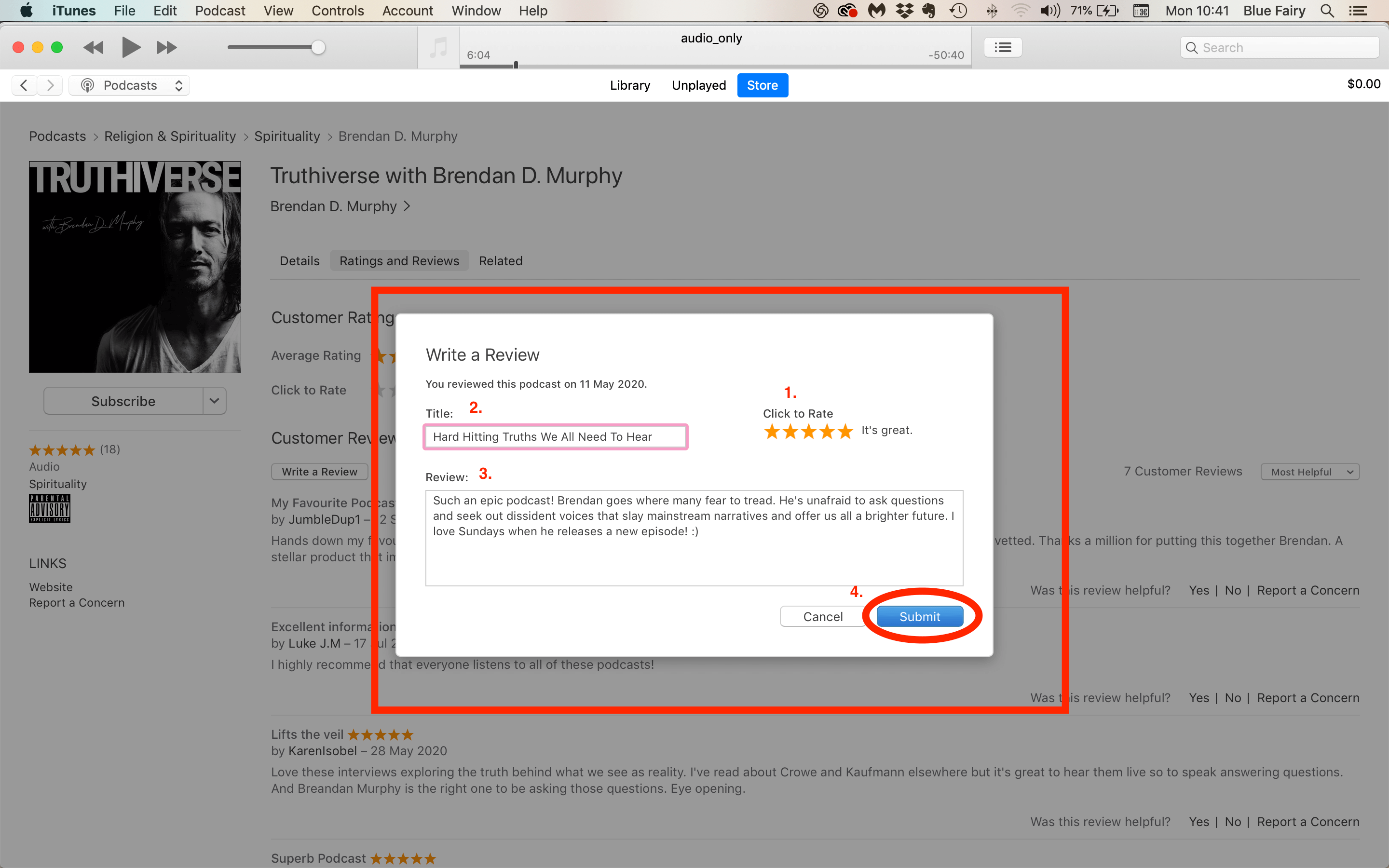I Like to Listen 🎧
I Prefer to Watch 🎥
YouTube Video Episode
BitChute Video Episode
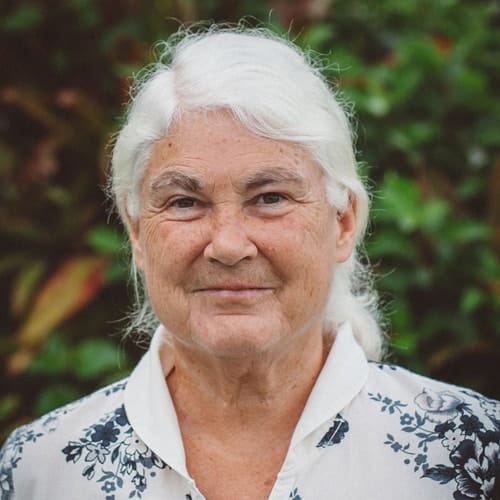
Today's Guest
STEPHANIE SENEFF
Dr. Stephanie Seneff is a Senior Research Scientist at MIT’s Computer Science and Artificial Intelligence Laboratory in Cambridge, Massachusetts, USA. She has a BS degree from MIT in biology and a PhD from MIT in electrical engineering and computer science. Her recent interests have focused on the role of toxic chemicals and micronutrient deficiencies in health and disease, with a special emphasis on the pervasive herbicide, Roundup, and the mineral, sulfur. She has authored over three dozen peer-reviewed journal papers on these topics.
You'll Learn
- Why glyphosate is a bigger problem than any virus
- How glyphosate undermines healthy cellular function
- Why the toxicity of glyphosate leads to a “viral” explosion in the body
- What the virus is ACTUALLY doing in your body
- Which microbial pathways are disrupted by gylphosate…
- …and how this destroys our health.
- More reasons why Terrain Theory supercedes Germ Theory
…and much, much more.
Stephanie Seneff brings a unique scientific angle to the convid discussion, highlighting some issues you aren’t likely to hear about anywhere else.
Please subscribe, drop a review, and share this information widely.
Thanks in advance for supporting the nascent emergence of deep human self-awareness – and the FREEDOM this will bring us all.
Episode Links and Resources
- I am text block. Click edit button to change this text. Lorem ipsum dolor sit amet, consectetur adipiscing elit. Ut elit tellus, luctus nec ullamcorper mattis, pulvinar dapibus leo.
Transcript
Stephanie Seneff Full File to Edit [00:00:00] Brendan D. Murphy: Ladies and gents welcome to another episode of Truthiverse and I'm your host, Brendan D. Murphy. And this week I am joined by Stephanie Seneff, who is a Senior Research Scientist at MIT, who has been looking into the other causes of the viral pandemic, what's really going on and particularly focusing on glyphosate if I'm not mistaken. So with that said, Stephanie is quite well-known. I will let her fill in the blanks. Welcome to the show Stephanie Seneff. Thanks for taking the time. [00:00:28] Stephanie Seneff: Thank you so much for having me. [00:00:29] Brendan D. Murphy: So you're, if we can go a little bit into your, just a brief sort of run down of your background and how you came to be interested in this kind of work, maybe. [00:00:39] Stephanie Seneff: Okay. Yes. Sure. In fact, most of my career, I was developing Computer Spoken Dialogue systems and I'm a computer scientist. So this is really quite far a field from where I started this work that I'm doing now. And, but it was about 12 years ago that I got concerned about the autism epidemic in America. [00:00:57] And I was frustrated that they were not [00:01:00] particularly interested in seeing if there were some chemicals that might be causing the autism epidemic. I felt like it must be something in the environment. And after five years of searching, it wasn't until five years of looking that I found glyphosate and it was just very serendipitous because I happened to be at a conference where Professor Don Huber gave a two-hour presentation on glyphosate. [00:01:18] And I'm embarrassed to admit that at the time, I didn't know what glyphosate was. So and probably many of the audience don't know what it is either. So I will just say it's the active ingredient in the herbicide, Roundup, which many people are familiar with, very common, most common herbicide in the world. And the United States uses more per person than any other country in the world. [00:01:37] And the United States is also very sick. We have a terrible statistics on obesity, and diabetes, and heart disease, and Alzheimer's and autism, of course was the one I was most interested in. And all of those diseases are going up dramatically in our country exactly in step with the dramatic rise in the use of glyphosate on corn crops is a perfect match statistically, because the trends, the time trends of [00:02:00] these, other product usage against the time trends of all these diseases. [00:02:04] And I believe it's causal and people just dismiss this evidence as saying, correlation doesn't mean causation, but these are stunning correlation coefficients with near perfect match for all of these diseases. And of course our country is in a complete crisis with respect to health care. They politically, they just can't figure out how to, how to pay for it because so many people are sick and we need so much care. We have such expensive health care services because of our pathetic situation with our health as an entire country. And, so anyway, I've come to believe that glyphosate is a primary factor in all of this, these problems that we're facing and other countries also start to face the same problems once they started adopting Western diet. [00:02:43] The problem is that glyphosate is all over the food supply. And that's been confirmed by groups that have been studying it. Other, not the government doesn't bother to test, but, but many organizations are testing various foods and finding high levels in foods that are very popular with children [00:03:00] like Oreo cookies and, oatmeal and, Cheerios and these little Goldfish crackers . All these things have lots of glyphosate. And it's not just this, is GMO Roundup Ready crops, which are sprayed throughout the season because they're resistant. They've genetically engineered these crops to be resistant, that's: corn, and soy, and sugar beets, and canola, which isn't very popular oil. So many of these foods are very basic in the Processed Food Industry. And then there's also a set of crops that are sprayed right before harvest and has a desiccant. [00:03:31] They're not, it's not being used for the weeds, but it's being used actually to kill the crop, cause it to go to seed and increase the yield of the harvest. And make it easier to clear the residue once you harvest the crop. And so it's, and that's a critical one because that relates to the issue of COVID-19. [00:03:46] My suspicion is, is the biofuel industry and that's where it gets very interesting. The biofuel industry processing the residue of the crop after you harvested into usable fuel. And then putting it into vehicles [00:04:00] driving on the street, trucks and buses and whatnot. And I suspect, and this has not been proven. It's just a theory, but I suspect that what's happening is the glyphosate is getting out into the air in cities that are adopting biofuels and the people are breathing the glyphosate and the glyphosate is hurting their lungs in such a way that they're much more susceptible to COVID-19 because glyphosate in my studying, I feel that glyphosate, impairs the immune system. [00:04:24] Brendan D. Murphy: Sure. [00:04:25] Stephanie Seneff: So, that's the why they can't fight off the virus. [00:04:28] Brendan D. Murphy: Sure. Okay. So you're looking at a toxic cause for something that we are being encouraged to believe is a viral phenomenon. But, I've been skeptical of that from the beginning because I've just learned to be skeptical of whatever the establishment tells us. [00:04:43] But thanks to people doing work like yours. We have pulling together a lot of information that shows that what the official narrative is very far from reality. [00:04:56] Stephanie Seneff: Yes. I think what, what really caused people to [00:05:00] get really worried was because in certain cities there was a very rapid rise. I think there, so my belief is, first of all, viruses are really fascinating and I believe viruses are actually trying to help. They're not trying to harm you. They're not out to get you. They're trying to help you. And that's actually very interesting story, which we could get into if we have time. [00:05:16] Brendan D. Murphy: Absolutely, yeah. [00:05:16] Stephanie Seneff: Because I can see how the virus would help you if you didn't have all the problems with the toxic chemicals. So they're trying to solve a problem that the chemical has caused. And then in there, in the process of trying to solve it because you are so poisoned by the chemicals that their, their plan gets derailed because the chemicals are messing up the enzymes that are supposed to do the job that the virus has in mind. [00:05:39] And so you end up getting really sick because your immune system goes into overdrive and can't clear the virus. And this is all because of the toxic chemical exposures. And I'm sure it's not just glyphosate, but I think glyphosate is a key one and glad to say I singled it out because we consider it to be so safe. [00:05:55] So there's many other toxic chemicals that we are aware dangerous. Many of them [00:06:00] are also used in agriculture. But glyphosate is considered wonderful because it's so, it kills all plants, except those that have been engineered to resist it. But it's perfectly harmless to humans and if you believe that, you're very naive because it's not, chemicals don't work like that. [00:06:14] Something that kills plants also kills humans that's not reasonable that it would be completely safe for us. So I think Monsanto has pull the wool over our eyes and unfortunately has duped the entire world population into believing that this chemical is safe. And therefore they don't study it. Recently, there've been a lot of papers coming out. [00:06:33] I'm very encouraged because the toxicologists are finally thinking maybe this stuff is toxic after all, we better take a look at it. Cause they're not going to waste their money, studying it if it's perfectly safe. So once everybody believes it's safe nobody looks and it's insidious, its toxicity is subtle, and insidious, and that's why we, you don't see it if you just try to do a short-term experiment to see short-term damage. It, because of the fact that I think it insinuates itself into your proteins and messes up their [00:07:00] ability to do their job. And it happens slowly overtime so you accumulate glyphosate in your tissues over time, and eventually you get to the point where things start breaking. And, people get all kinds of different results because of their difference genetics, their different genome, their different mitochon--, microbes in their gut. People have different, a lot of differences and so their particular manifestation of glyphosate poisoning will be different from person to person. That's why there's so many different diseases that are affected by it, but it's a basic toxicity that gets into your system and slowly erodes your health. [00:07:33] Brendan D. Murphy: So, it is a cumulative thing. A lot of the time we have this mentality and now like Western culture where firstly, we think any kind of innovation, technological or chemical or whatever is wonderful. [00:07:42] And then we don't bother looking at what the possible long-term effects might be. And we also have this mentality of, if it doesn't kill me instantly, it's safe. [00:07:50] Stephanie Seneff: I know. And of course there's so many things going on too with epigenetic effects and we're seeing becoming now more and more aware that many of these chemicals affect not [00:08:00] just the fetus, but the actual gene, the germ cells of the fetus. [00:08:03] So this is actually the chi, the grandchildren of the person who is exposed. So they're finding in recent studies, women who are pregnant when they're exposed to these toxic chemicals and glyphosate is one of them. That sometimes if it's a low enough level, the woman is fine. Her child is fine. Her child grows up and has children. They might even be not too bad, but by the time we get to the grandchildren, you start to see some serious effects. It's really quite amazing because it offers the epigenetics of the germline in the fetus to affect the later generations. And this has been shown with its very fascinating results that these, and it'll be things like his severe genetic mutations that will cause gross defects in the child that, because of, very rare, monster type things like, the conjoined twins or missing limbs, that sort of thing can happen in later generations from exposures of the grandmother, which is quite amazing to me. [00:08:56] Brendan D. Murphy: Yeah, that is, that's a very interesting idea that it's passed. [00:09:00] It's the most severe in the grandchildren rather than the children. [00:09:04] Stephanie Seneff: It can skip a gene. In fact, there was a study. There've been multiple studies now that have come out very recently on Roundup, and glyphosate, and looking at exposure with the ma--. They'll study mice or rats. And they'll expose the pregnant mouse or the pregnant rat over a period of time while they're pregnant. [00:09:17] And sometimes when they're, during lactation, when they're nursing. Just over that period, but only expose the mother. Don't directly expose the fetus, but the fetus is getting exposed, being exposed indirectly because of the mother's exposure. And then, but low level so that the mother's not really obviously sick. There's no problem. [00:09:35] And then you can see as a and then they can look at the later generations. They find trouble in the later generations. Chi, the grand, children of the grandchildren, great grandchildren, that sort of thing. I guess it can last several generations. And it's a memory of, of an effect that the, that the germline was observing in utero and then caused a, a different, change in policy for the way the whole thing operates. So that's really a high level disruption of the [00:10:00] whole organism in terms of how it works. [00:10:02] Brendan D. Murphy: Yeah. And wow. So from the grandchildren, say the generation that's most heavily affected, how does it play out from there as far as you're aware? [00:10:11] Stephanie Seneff: It's just, it's things like shortened gestation and smaller size, those kinds of things that are more vague, that you see early birth type of thing. Infertility, like the litter will be smaller and these kinds of things, but then there were these, if in this one study, they were these way over, over the probability of having. There were three different monster births. [00:10:32] It was like conjoined twins and missing limbs that kind of thing that occurred in the, I think it was in the grandchildren of the mice that were exposed in that study if I'm remembering correctly. So they were seeing all these effects showing up in the grandchildren. [00:10:46] Brendan D. Murphy: Wow. That's not small. These are not small things. These are major things. [00:10:51] Stephanie Seneff: And fertility is a huge problem as you probably know. Certainly in the United States, we've got massive numbers of people who are spending a lot of money, trying to [00:11:00] get pregnant with in vitro fertilization, and things like that. Birth rates are down . Fertilization is definitely, and it's been shown that they, that glyphosate messes up sperm and decreases their motility, decreases their numbers. So, you get low sperm count and, the sperm are defective when they're exposed to glyphosate. [00:11:17] Brendan D. Murphy: Yeah. Yeah. It's very sobering. I've heard this, but okay, so we've got this generational thing going on. We've got the, COVID-19 links to toxicity. [00:11:28] Maybe let's just come back to that for a minute. And we've got a couple of other interesting tangents we can go down. But we've been looking at this sort of pandemic, the virus, we keep hearing about it. You're all looking around the world at circle COVID hotspots, and you're looking at it from the point of view of toxicity. [00:11:45] So what is the pattern that's started to emerge to you. What have you learned through your research? [00:11:51] Stephanie Seneff: Yes. I noticed, I immediately suspected, pollution, air pollution, just because Wuhan is a pretty polluted city. And then when Italy got hit so hard in Lombardy, and [00:12:00] Lombardy is known to be a highly polluted area of Italy, a lot of air pollution. [00:12:04] And then when it came to New York City, and again, there was just skyrocketing. What seems to happen in places that have air pollution, but not all places that have pollution. That's what's interesting, is that the virus is arriving. I think there is a co--. I think there is a virus and it probably is a new virus and it's probably causing a new disease. [00:12:22] But my opinion is that we wouldn't have even noticed it if not for the toxicity that we're exposed to. This is the toxicity that made the virus be so dangerous. And so in places where you don't have the toxicity, the virus is harmless. That's what we're seeing in my opinion. And so New York city, when it first arrived there and that's what terrified the United States and got us all to put our masks on, because which I've just completely fed up with the masks, I must say. There's like this, absolute, people are so fearful in this country and it's just really sad to see they're just terrified. And of course there's, the government has promoted that concept. And it's interesting how people can, [00:13:00] that fear can really grab hold of you. And it works unfortunately for many people. But the New York City situation was very dramatic cause they were on the news. [00:13:09] They showed all these, ICU overwhelmed and people dying because there wasn't a vent, a ventilator for them and stuff like this. Like they were going to die because they couldn't, there wasn't enough equipment. There weren't enough rooms. It was very, very frightening that this whole thing happened in New York City. [00:13:24] So what, and then of course, when you look at mortality rates, it's just way out of line in different countries. And it's very interesting that patterns show up. And I zeroed in on the United States, which has a very high mortality rate compared to other countries. And when you compare the United States with places like Taiwan, Taiwan is right off the shore of China. [00:13:44] So it should have been hit hard. It should have been hit first. And Taiwan has to this day, it's had, I think a total of 450 cases over the country with seven deaths. Seven death, so that's just nothing, and so Taiwan, and so the course of the story is comes out, [00:14:00] whole Taiwan was so good at social distancing, at testing and keeping all these people apart and all this stuff. [00:14:06] They always come up with these explanations for why, a country does so well in another country doesn't. But that just makes no sense to me that a country, Taiwan has plenty of air pollution in Taipei. I actually lived there for one year. My husband was on sabbatical in Taipei and I spent several months there. The air was very polluted. [00:14:22] I had a really hard time with it in Taipei, which is a big city in Taiwan. But that air pollution doesn't seem to cause a problem. So it's interesting that the air pollution, it seems to be a problem only in the cities, only in certain cities. And when you look at where their pollution is a problem, it's the places that use a lot glyphosate, and that are leaders in the biofuel industry. [00:14:45] And that's where you get the United States and Europe, because Europe has actually been very progressive with biofuels. The whole concept is to try to reduce the consumption of pet petroleum-based fuel, which sounds like a good thing. And actually it turns out it's not good in terms of producing [00:15:00] climate change. The carbon dioxide in the air, the whole concept is, it's going to improve that but it actually doesn't. When you look at, when you look at it, scientifically, you realize that because you're removing forest to grow these crops that you're going to use for biofuel and then you use a lot of energy to actually turn the crop into biofuel that releases carbon dioxide. And, and then of course, all the chemicals that you use on the crops, because we have such a chemical-based agriculture approach are really bad for climate change. [00:15:29] So it really doesn't make any sense to use it for that purpose. And, and you lose it for the other, for the better purposes that you would use for, just creating soil from decayed crops. It's really a much better natural or like manure. They use manure as well and cow manure has become a huge problem just because we have these concentrated CAFO cows, these concentrated animal feeding operations, where the cows are all being fed toxic food with lots of glyphosate and their manure becomes toxic too. So you can't actually use the cow manures as a fertilizer, which would actually be a really [00:16:00] good fertilizer if it weren't for all of that. So we spread this poison all around. Of course, not just glyphosate. We use a lot of other chemicals on our crops as well. And even the chemical- based fertilizers are not good either. [00:16:10] So, the food system is just really broken. I feel. But you're looking at air pollution, there've been like the US had a study out of Harvard that looked at counties across the country and found a correlation between nanoparticles, which is just measure of air pollution, nanoparticle counts across the different counties and the death rate from COVID-19. [00:16:30] They found a strong correlation between those two in the United States. And then there were three different papers that showed up in various parts of Europe that also found a correlation between air pollution and COVID-19. But then if you look at a country like Nigeria, I was looking different countries around the world, and Nigeria is extremely remarkable because they have very bad air pollution. [00:16:50] Something like 94% of the population is exposed to air pollution that's higher than the levels that the WHO consider safe. And they had the worst, the [00:17:00] most polluted city in the world was in Nigeria in the study I found from 2015. So really bad air pollution and then incredibly good COVID-19 compared to the United States. For every one person that dies from COVID-19 in Nigeria there are a hundred that die in the US. It's a hundred fold. That's not a small change, hundred times as many deaths from COVID per population in the United States compared to Nigeria. [00:17:26] Despite this heavy air pollution, despite this large population of, a great deal of poverty and crowding in the inner city, no social distancing, all these factors that should be sending COVID through the roof and yet, they don't even notice that there's anything going on different from what their normal situation is. [00:17:44] So they can't get serious about this virus because it's just not happening to them. So it's very mysterious that a country like the United States would be so hard hit and a country like Nigeria would not. It's just very mysterious and I think that the key is the glyphosate messing up the [00:18:00] immune system, making it killing the innate immune system so that when the virus comes into the lungs, the innate immune system can't clear it. [00:18:07] And then, so the it's the body brings in the adaptive immune system, which involves releasing all these cytokines, which causes what's called a Cytokine Storm. You get inflammation and just intense reaction to the virus and it's actually your own immune system that ends up causing all the serious problems that occur in these patients who have this intense overreaction to the virus because their innate immune system can't clear it. [00:18:31]Brendan D. Murphy: Okay, interesting. [00:18:32]Stephanie Seneff: Of course it, the question that comes up when you say that there's all these correlations and all these diseases that appear to be. [00:18:39] Glyphosate appears to be a causal factor in all these different diseases. It immediately becomes a question of how could that possibly be true? How could one chemical caused so many different diseases? Is the question, of course, that I get all the time. And I, so that I was, of course also wanting to know how could one chemical cause so many diseases. [00:18:57] And so I looked into glyphosate's mechanisms of [00:19:00] toxicity, even looking at understanding what that molecule is and how it works. And it turns out that glyphosate is a, is an amino acid. And so there are a number of amino acids that are coding amino acids that our biology uses to make proteins. [00:19:14] They're the building blocks of proteins. There's about 20 of them. And they are the, they're the famous, GN, the genetic code with the four letter code that people should know about. That code codes for amino acids. So there's three letter, three letter sequences code for different amino acids. And you basically read off the code, like a machine. [00:19:33] It's almost, just like computer science. You're like we read off the code and you translate it into the amino acids and the system knows how to do that. And so they will assemble these amino acids like beads on the string to make a protein. And then the body codes for all these different proteins that do all kinds of different things in the body, to make everything work properly and the proteins are the working horses of the body, really they're really crucial to biology. [00:19:57] And, so glycine is [00:20:00] a, is one of those coding amino acids. And it's in fact, the smallest coding amino acid. It has no side chains. So it's very simple and that makes it very important in many proteins. So many proteins have essential, what's called Essential Glycine Residue that if you change that glycine to something else through a genetic mutation , it can cause that person to be non-viable. [00:20:20] So if you have a genetic mutation in an infant, somewhat, in a critical glycine residue, it can basically make them unable to survive. It can be that bad in certain cases. And of course, there's lots of studies about where mutations caused diseases. So you can go and research in literature and find individual examples of very special glycine residues and various proteins. [00:20:43] The reason why I zeroed in on this idea that glyphosate actually is being mistaken as glycine and being put into the protein by mistake during the assembly process. This is the key, what I believe to be the key mechanism of toxicity of glyphosate, which is really demonic. And it's not [00:21:00] something that never happens. [00:21:01] If people are aware, there are several examples of that toxic chemicals that work that way. They substitute for an amino acid. I don't know of any one that substitutes for glycine. So that makes glyphosate unique, but there are other examples of toxins that substitute for other amino acids that cause disease in the same way of messing up the proteins. [00:21:20] So it's not an unreasonable thing that could be going on. Monsanto, absolutely denies that this is possible. So they're being very insistent that I'm crazy and that this can't possibly be true. But when you look at the evidence for the specific protein that is known to disrupt in the plants, they've really zeroed in on this one protein, which is called EPSP synthase. And it's in the Shikimate pathway. It's a very important biological pathway in plants, also in microbes, but it doesn't occ--. We don't have that pathway ourselves, don't have that pathway or that enzyme, none of that. [00:21:53] So that's why they say, it's very safe for us because the enzyme that it affects is an enzyme we don't [00:22:00] have. And it's a nice argument. You would really love to believe that was true, but one problem of course, is that our microbes do have that enzyme and they use it to make really critical nutrients for us. And so when they get hurt by glyphosate, they're unable to keep up with the nutritional needs that we have that we depend upon them for. So that's certainly one thing that I think is primary, that specific enzyme. But more than that, if you think that what is going on with that enzyme could go on with other enzymes as well and then you find other enzymes that would be effected, then you can start to find out how you could explain all of these diseases. So it's a very big puzzle that you can work out, by learning about the other proteins that matched the pattern of the one protein that they've identified as being disrupted by glyphosate. [00:22:47] What's so interesting is that protein has a glycine residue at the place where it binds a substrate that's called PEP. And if you change that glycine residue to alanine, which is a very minimal [00:23:00] change, if you change the code, so that's no longer glycine, you make that enzyme completely insensitive to glyphosate. [00:23:06] This is why I believe that's what's happening because Monsanto found this out. They know that this is the case. And when they make this GMOs that are resistant to glyphosate, they make them by getting rid of that glycine at that site where PEP binds. And so there's other proteins, there's even another proteins that bind PEP at the site where glycine is highly concerned, very specific simulation of exactly what's going on with that protein that are happening with other proteins. [00:23:32] And those proteins would also then be affected the same way if that's the mechanism. It would happen to the other protein as well and then other proteins that basically have worked out a specific what I call Glyphosate Susceptibility Motif in particular proteins that have exactly a very similar setup, so the setup that's in that enzyme that gets disrupted. [00:23:54] So that's how the scientific argument goes. I guess that may be a little bit hard for people to grasp, because [00:24:00] I know it's a little bit difficult. You know, biology, but I don't know whether you're completely lost or whether this is making any sense to you, but . [00:24:07] Brendan D. Murphy: It's making sense that it would be fantastic right now if we had a visual aid on the screen. [00:24:11] Stephanie Seneff: Yes, that's true. [00:24:15] Brendan D. Murphy: But, it's really interesting, a lot of research. So let's back up and recap because as you're speaking, there's a lot of, there's a lot of words, biological technol, tech, technical terms and things being strung together. So when glyphosate, what is the action of glyphosate? [00:24:28] Just in a nutshell, in terms of the damage that it's doing in humans beings, and this insertional action that you've struck upon. [00:24:37] Stephanie Seneff: Yes, so if it is doing this and I can identify proteins that would be affected the same way and then if they were affected, I can identify diseases that would occur. [00:24:46] And then I can see the glyphosate causes those same diseases. So that really works out very nicely as far as putting the puzzle pieces together. And the good example is, is liver disease. We have an epidemic in Fatty Liver disease in our country and, a cause of [00:25:00] fatty liver disease, you will get fatty liver disease if a protein called PEPCK is disrupted. And PEPCK is a protein that binds a PEP, the same PEP that the other protein binds at a site where there's also a glycine that's highly conserved. In other words, it's exactly the same setup as the setup in the enzyme that gets affected by glyphosate. So you would highly predict their PEPCK would also be affected in the same way. [00:25:26] And if it were, would cause a Fatty Liver disease, and then they've shown that when you expose, first of all, they've shown that human with Fatty Liver disease, there was a study that showed that they had higher levels of glyphosate in their urine compared to humans without the disease. And the ones with more extreme cases just had more glyphosate in the urine than with ones with less extreme cases. [00:25:45] So it points to glyphosate as being causal in the, in the disease circumstantially just from the urine data. But then they did a study on rats, where they exposed them to levels of glyphosate that were below regulatory limits over a [00:26:00] period of months. And they showed that glyphosate caused Fatty Liver disease in those rats. [00:26:04] So in other words, there's evidence that glyphosate causes their disease. And then if you say, the mechanism that's taking placed with the EPSP Synthase would be exactly modeled by the same mechanism in PEPCK, so you can expect it to mess up our enzyme, which is a really important enzyme in the liver in the same way that it's messing up the enzyme in the plants and in the microbes through the same process, which is substituting for that glycine residue at that site. [00:26:32] Does that make sense? [00:26:34] Brendan D. Murphy: It is, it's, it is making sense. It's, it, is a lot to take in at the same time. [00:26:39] But Stephanie is pulling apart the glyphosate situation here and how this is affecting us and how it connects into the COVID-19 or the COVID-19 epidemic which, as my listeners know, if you've been following the series so far, we've been very skeptical of this. And we've been pulling it apart with guests like Dr. Andy Kaufman, Dr. Robert Young, David Crow, the late David Crow was my first [00:27:00] interview. And, all these people have been taking their own unique experience, and expertise, and pulling apart scamdemic from different angles. [00:27:07] And we've focused, I've definitely focused a lot, Stephanie, on the, the angle of the medical microbiological exosomes, the immune system, what's going on. And the role of toxicity has come up repeatedly in this whole thing, because as you've pointed out and, we've had the horrific air conditions of places like Lombardy, and Wuhan, and around the world. There are other places obviously where people are constantly breathing in these poisons. [00:27:34]And cyanide was one of them that came up as well. So my point is with this is that I don't, I don't feel like we need to even invoke the virus concept. That's just my personal angle on this. And I liked what you said earlier, at the start, where the viruses in general and not, they've been painted as an enemy, but my understanding learning from people who know a lot more about it than I do is that viruses are endogenously produced. [00:28:00] [00:27:59] So we make them in ourselves and therefore they're not external invaders. They're not something we need to be afraid of. And I liked what you were saying about that, Stephanie. So, that's the angle we've taken so far on the show, but we're gonna, we're gonna hone in on the, [00:28:14] Stephanie Seneff: I can do that. [00:28:15]Brendan D. Murphy: I, yeah, I would like you to, please like, you, you want it to talk microbes and bacteria and we can go from there into that other stuff as well. [00:28:21] Stephanie Seneff: Right. We can certainly go directly into the viruses because of course the microbiome is so important to our health and we're starting to realize that. [00:28:30] Over the last 10 years, I think because glyphosate is wrecking the microbiome that's why we're noticing all of a sudden, all the things that used to do for us that it's not doing anymore, because I would say it's poisoning those microbes. And it's really fascinating to me, we think of pathogens as bad guys and I think they're not, I think they're just the microbes normally would reside in your gut, and they would mostly stay there. But then when you get in trouble with the gut, they actually have to go in and help out in a bigger way to actually go beyond the gut, into your general circulation. [00:29:00] And they're trying to actually repair problems that are being created by the toxic chemicals. [00:29:04] This is what I believe and not just the bacteria, but also the viruses I believe viruses are and as you say, it's a question of where, what is their origin. They're certainly around everywhere. And, and I think they're even agents of evolution. They're really fascinating cause they're just little bits of hardly live, religious little bits of RNA inside an approaching code with a lipid thing wrapped around it, lipid envelope. They're a very simple thing in a whole lot, like exosomes and exosomes are also something that we've really become much more aware of just in the recent past. It's really fascinating biology. I've become very interested in the whole concept of exosomes and in particular, not just exosomes, but actual sharing among the cells of materials that they pass around among each other to help each other out. And the virus I think, is part of that whole system of, you think of exosomes as things that, for example, a dying cell might release a lot of exosomes before it [00:30:00] dies to provide nutrition to the rest of the community before it disappears. To not just, it's a way to be efficient about not wasting the nutrients that it has in hand to allow other cells to be able to take advantage of it. Exosomes are really quite cool cause they're little package, hiding inside a lipid envelope and they could just be shipped around in the blood and they can be put anywhere really in the body. [00:30:21] So they're like little nutritional packets, like little pills that they're providing to the rest of the community as the cell, dying cell is giving up the ghost and then sharing with the community what it's got left. It's inheritance in a way of what it's got left after it's died. [00:30:38]But the viruses, there's a whole other aspect of this that I haven't, that I'm afraid to go into because it's going to be too technical, but it does. It's really fascinating. And it has to do with how glyphosate messes things up because of these enzymes. There's so many enzymes that I'm aware of a whole class of enzymes that would get messed up by glyphosate because of this problem with the glycine substitution and those enzymes are [00:31:00] usually responsible for making the mitochondria healthy. [00:31:02]The mitochondria are the places in the organelles, inside the cells where they produce ATP, they produce the energy for the cell and mitochondrial dysfunction is associated with all kinds of diseases. In fact, all of these diseases that are going up exactly in step with glyphosate usage have been shown to have issues with the mitochondria as a component of that disease. The mitochondria are not working properly and they spew out these reactive oxygen species, these toxic, reactive molecules and they don't, aren't able to make ATP efficiently. [00:31:34] And so the viruses actually have a whole mechanism in mind that would restore the health of the mitochondria. And it's really fascinating what I'm learning. And this is also related to Sally Fallon's work. I don't know if Sally Fallon... [00:31:46] Brendan D. Murphy: Yeah. I've actually got her scheduled. Yeah. I've got her scheduled for the show, she's great. [00:31:51] Stephanie Seneff: Yes. Yes. And I've been reading her book about the infection myth. And she maintains that the virus is not real and all that same thing that you're saying. [00:31:58] Brendan D. Murphy: Yeah. [00:31:59] Stephanie Seneff: She's a good [00:32:00] friend of mine, so I've been quite interested in her, in her take on it. I think my feeling is that exosomes and viruses are very similar, but they're not identical. Viruses are exosome on steroids because the virus has this the ability to reproduce. [00:32:14] And that's a crucial difference between the virus and the normal exosome that it actually can go into the cell and reprogram the cell to spend, to get preoccupied with making more viruses. So the virus goes in and then many viruses come out because the cell has been able to clone that virus using the whole machinery of just a cell reproducing making two cells. [00:32:35] You just make two viruses by copying that RNA and making them a new protein code, making in a new lipid envelope and shipping that guy out. So there's a, the virus is very much more powerful than a normal exosome because it can reproduce. That's what distinguishes it in my view from an exosome. Where the virus came from is a big question. [00:32:55] And of course there's many viruses that then infect bacteria, so you have these, the [00:33:00] human organism and then you have these individual one cell bacteria. And then you have these little pellets of viruses that aren't even really a cell. They're just a container of nuclear material. [00:33:10]It's really fascinating, these different levels of life. But that virus has this interesting set of genetic code inside it that can do really interesting things and that the COVID-19 virus, it gets in on the H2 receptor. And it has the enzymes that it needs to be able to do what it needs to do, which is just basically get into a sick cell reproduce itself and then go out and go to some other cells and continue to spread. [00:33:36] And the virus is actually, it was what I discovered in my research is that it looks like what the viruses are doing is trying to repair the mitochondria. They're sick. And it's really fascinating because if I get into the lung. And, and it caused all these, it seems to happen, which attracts the macrophages to come in to the lungs than those of the immune cells. [00:33:57] And then it also brings in the STEM cells, these [00:34:00] mesenchymal STEM cells that come from the bone marrow. They go in and the mesenchymal STEM cells actually release their mitochondria, and deliver them to the macrophages. So once the macrophages acquire these new, healthy mitochondria from the bone marrow, they become empowered to be able to clear the virus. [00:34:16] So there's a whole machinery in place that the virus launches through all the signaling cascades that allows the macrophages to be repaired. Macrophages have these sick mitochondria. They can't work properly because of that. They can't clear garbage. They can't clear the viruses. But once they are empowered by this whole mechanism that's takes place in response to the virus, what ends up happening is the macrophages acquire healthy mitochondria that can then cause them to work properly and be able to clear viruses. And so it strengthens the immune system when you're done with the virus infection, it strengthens the immune system and allows it to maintain a healthy body much better in the future. [00:34:56] So it actually improves your health. But the problem is when you have all [00:35:00] these toxic chemicals, they're messing up that process as well, because that process is very intricate and complicated. And when the enzymes aren't working properly, it goes, it gets derailed. So it, the virus is trying to fix the problem that was created by the toxic chemical. [00:35:15] This is what I think, but the toxic chemical actually causes the repair process to be broken as well and that's when the person ends up dying. Just because of the toxic chemicals have messed up the whole system to the point where this solution, that in a sense the virus has in mind is not going to work because of the chemicals. [00:35:33] Does that make sense? [00:35:34] Yeah, absolutely. Absolutely. And it's a really interesting, a lot of, thinking in research there, I'd love to know more about that as far as reading papers and that kind of stuff goes . [00:35:41] I have been fascinated by viruses actually for many years. And one thing that I looked at was the flu virus. The flu virus is one that we're all told to get the flu vaccine and just really terrified of the flu virus. [00:35:54]So I actually looked into what the flu virus does and it's very interesting because it actually, infects the muscle [00:36:00] cells and reprograms them to make more flu viruses, but then it coats itself with this extra cellular matrix material that provides sulfate. And sulfate is something that I've really focused on. [00:36:10] Sulfate deficiency, I think, is a major driver behind modern diseases and glyphosate is causing the Sulfate deficiency problem. But these flu viruses load themselves up with this coat that has a sulfate in it, and then they go out and enter the world, into the circulation, and then they feed the sulfate essentially to the macrophages. [00:36:29] So the macrophages are suffering from, these are the immune cells and macrophages. Those are the guys that are supposed to clear the virus, but they're sick. They're suffering from both the Sulfate deficiency in their outer membrane and dysfunctional mitochondria and the two go together. Actually, it turns out it's very interesting that the sulfate helps to maintain healthy mitochondria. [00:36:48] And so the flu virus is providing the immune cells with the sulfate that it stole from the muscle. So you get muscle aches and pains in your muscles are really, you feel sick because of [00:37:00] that. But the flu virus is making a decision to help to improve your immune system by stealing Sulfate from the muscles and providing it to the macrophages. [00:37:08] So that's just really interesting. And I think when you look at every single virus, you're going to find that it's helping to solve a serious problem that you have as a consequence of toxic chemical exposures. That's just a general tre--, a general philosophy that I have, that this is what the viruses are trying to do. [00:37:25] And, but of course it's just as the virus sort of implements a very intense program to try to fix things and in a way to fix the mitochondria, you have to shut them down. So with the, with this COVID-19 virus, it's coming in and trying to eventually is trying to systemically fix the macrophages because they fix the mitochondria, because the body is so sick. And so the virus can discover that this person is really in trouble and needs to have, no stops, just go ahead and go for broke and really try to just reboot those mitochondria as best you can. But then it can just get too intense and that's why the person dies. [00:37:59] So it's [00:38:00] just because of the toxic load is so great that the viruses' plan gets derailed. That's a message that I would say that's what's causing people to die from these viruses. In a way, the viruses selectively killing the people who would have died anyway, shortly thereafter, because they were so sick. [00:38:17] And you're seeing that with all the comorbidities that people who are dying are often very old and they're often have all kinds of different comorbidities: obesity, diabetes, heart disease, those kinds of things. So they are people who are close to death anyway, and the virus is trying to fix a major problem that's going to kill them down the road. And in some cases it succeeds. And so I think there are people who are going to be better off because of what the virus has achieved in terms of repairing their mitochondria. But the ones who are just too sick to make it are going to get end up dying. So I think that's the way I would explain it. [00:38:53] Brendan D. Murphy: Okay. So yeah, I find that to be an interesting angle that I haven't really seen floating around a lot. So [00:39:00] you're saying these people have a they're toxic, they have mitochondrial situation going on. They're deficient. And then this little viral package comes in, it's trying to reboot the system, it's trying to help the mitochondria, but in doing so, it is producing a very intense experience that is that some people are not surviving. Is that kind of the essence of what you think? [00:39:22] Stephanie Seneff: That's exactly right. Yes, that's really the right way to say it. It's just that, the body has to overreact to the virus because the body is so sick. [00:39:30] And when it tries to implement the plan, the virus has, the plan gets derailed because these toxic chemicals are affecting the proteins that are supposed to do the things the virus plans to do, but they don't work because the glyphosate's in the way. So it's just like the whole repair system is also broken. [00:39:46] Brendan D. Murphy: And you're only talking about glyphosate, I mean we're not even talking about all the other thousand of chemicals that we're exposed to every day. [00:39:53] Stephanie Seneff: You're right. It's so many chemicals and of course they were also synergistically toxic, so often different chemicals work together. And that's one [00:40:00] thing with glyphosate, it makes the metals much more toxic than they would otherwise be. [00:40:04] The Mercury, and the Aluminum, the Lead, and those things are going to be much more toxic in the presence of glyphosate because glyphosate disrupts the body's detoxing capability. [00:40:15] Brendan D. Murphy: Okay. That's really interesting cause if memory serves me correctly, I think, Lead Arsenate was one of the culprits that was fingered as a potential protagonist in this sort of outbreak, as something that's poisoning people. [00:40:27] And then you're saying it's synergistically toxic with glyphosate and many other things are so we've got this enormous sort of compounding rapidly compounding problem. If we just created cities say in a hypothetical scenario like that, we're not so rigorously polluted, if our air quality was just better, how would you see things playing out? [00:40:49]Stephanie Seneff: As I said, it's actually surprising to me that Nigeria does so well because they do have a lot of air pollution. And so it's not just air pollution, it's specific things in the air pollution. And that's why I think the glyphosate [00:41:00] factor, all those other things in the air pollution become much more toxic because of the glyphosate. [00:41:05] And so it really just puts it over the top, but without the glyphosate as what I'm suspecting that is a critical piece of the puzzle. And there are a lot of other things in the air pollution that are bad, and we know that. And in fact, and the biofuels are known to be worse than the regular fuel. [00:41:19] They've done studies where they've shown that they cause, more, more inflammatory response and they have higher levels of the nitrogen oxides and the sulfur oxides that are, part of the pollution problem. So they, the biofuels are by no means clean. They're much more toxic than regular, diesel fuel, for example, ethanol or the diesel fuel and gasoline. The biofuels are much more toxic, but the cyanide is another one. [00:41:45] I think it was cyanide that Zach Bush was talking about. I remember in a video that I saw , cyanide in the air. So there are all these things that, it's really unfortunate that we are not more willing to [00:42:00] go back to really, normal, organic agriculture that does not depend on chemicals. [00:42:07] And that includes both the fertilizers. We don't, we should be recycling them, the manure, to provide the fertilizer for the crops. But instead we have these very simple nitrate, phosphate fertilizers, and actually the production of those fertilizers also produces toxic air. So, the phosphate fertilizer plants are very polluting. [00:42:26] And, so we're just, we've got things so messed up as far as how we're doing our agriculture. If we could just start there. I think if we could go back to sustainable, renewable, organic agriculture as a starting point, I think many things would get better. I think just that alone would be such a huge improvement over where we are today. [00:42:45]Brendan D. Murphy: Yeah. Yeah. Just the removal of those chemicals from the, whatever you call it, the life stream, the life cycle would be phenomenal absolutely. So it sounds to me like you come down very much, we've got a couple of minutes left, there, I'm just looking at the clock, but it sounds like you, you would [00:43:00] come down more on the side of the Terrain Theory than the Germ Theory. [00:43:03] Stephanie Seneff: Yeah, absolutely. Yeah. Béchamp versus Pasteur, right? The whole battle Pasteur versus Béchamp. Béchamp definitely was right. It's the Terrain. That's the whole thing. And the viruses are our friends and of course the microbes are our friends too. And we certainly see that with the gut microbiome, as I said, there's so many things that they do for us. [00:43:22] And when they get poisoned by glyphosate, we get sick. And in fact that Shikimate Pathway that I mentioned earlier, that pathway is so critical because it produces these aromatic amino acids and they are precursors for our, for many important biologically important molecules, such as all the neurotransmitter, Serotonin, Melatonin, the skin tanning agent, Melanin, thyroid hormone, all of these things come out of that Shikimate Pathway. Some of the B vitamins. [00:43:46] So all of those things become deficient when our microbes are being harmed by glyphosate. And that's also part of the, affected the disease process with the glyphosate exposure that it messes up our gut microbes and prevents them [00:44:00] from doing their job, supplying us with critical nutrients. [00:44:03] And then if we get, for example, just Serotonin deficiency, that's linked with obesity, that's linked with violent behavior, that's linked with depression and all of those things are going up in our society. It could simply be a matter of Serotonin deficiency because the microbes are not producing the Tryptophan that's needed to make the Serotonin. [00:44:22] Yeah, there's so many levels to this. It's quite mindblowing really when you start getting into it. That is, that's so interesting. So unfortunately, I'm gonna have to start wrapping this up Stephanie. Ladies and gentlemen, our special guest this week is Stephanie Seneff, Senior Research Scientist at MIT. We've been breaking down the COVID situation from the point of view of glyphosate and toxicity. [00:44:42]Where do people follow at work? What is it that you would like them to know about you or, parting words or message as we leave here? [00:44:48] Yeah. Okay. I have a new website. I'd actually called Stephanieseneff.net, which is a lot easier to remember than my MIT website, which I still have, but you can link to the MIT website from Stephanieseneff.net. [00:44:59] So there's some material [00:45:00] there that will help you get a sense of me. And, I am writing a book. So there's a book called 'The Glyphosate Effect' that will hopefully appear early next year, if all goes well. So we're working on that right now, a book on glyphosate. And so, get a lot of information from that. [00:45:15] And then I'm just going to say, to stay healthy, I really believe in getting out in the sunlight without sunscreen, without sunglasses. Soak up that sun cause the sun is a very healing, resource of energy. And then I'm eating an organic diet of course, and eating highly nutritious foods, eat a lot of, foods you recognize as plants and animals. [00:45:34] They're just really basic foods. Don't buy soy protein bars even if it's organic. I wouldn't recommend the soy protein bar. So you really want to eat real foods organically grown. And with rich micronutrients, so lots of herbs, and spices, and things like that. And I think if you do that, you will be healthy and you'll be safe from COVID-19. [00:45:54] Brendan D. Murphy: Brilliant. Awesome. Thank you. That's, there's a lot of, we've gone from intricate science to common sense basics. I like that [00:46:00] great way to wrap it up. So thanks so much, Stephanie, for taking the time to chat to us. Ladies and gentlemen, I hope you've enjoyed this as much as I have and found it as thought-provoking as I have. [00:46:08] This has been Truthiverse with Brendan Murphy and our special guest, Stephanie Seneff. I will see you next week for the next show. Take care 'til then.
About the Truthiverse Podcast
Join Freedom Hacker, Truth Addict, and acclaimed author of ‘The Grand Illusion’ books as he cuts through the B.S. to get to the truth – whatever it may be.
Brendan and his guests uncover the mysteries of spirituality, geopolitics, health, medicine, freedom, personal development, exopolitics, the paranormal, and more.
No dogmas. No holds barred. Nothing off limits. You’ll need an open mind and your grown-up pants.
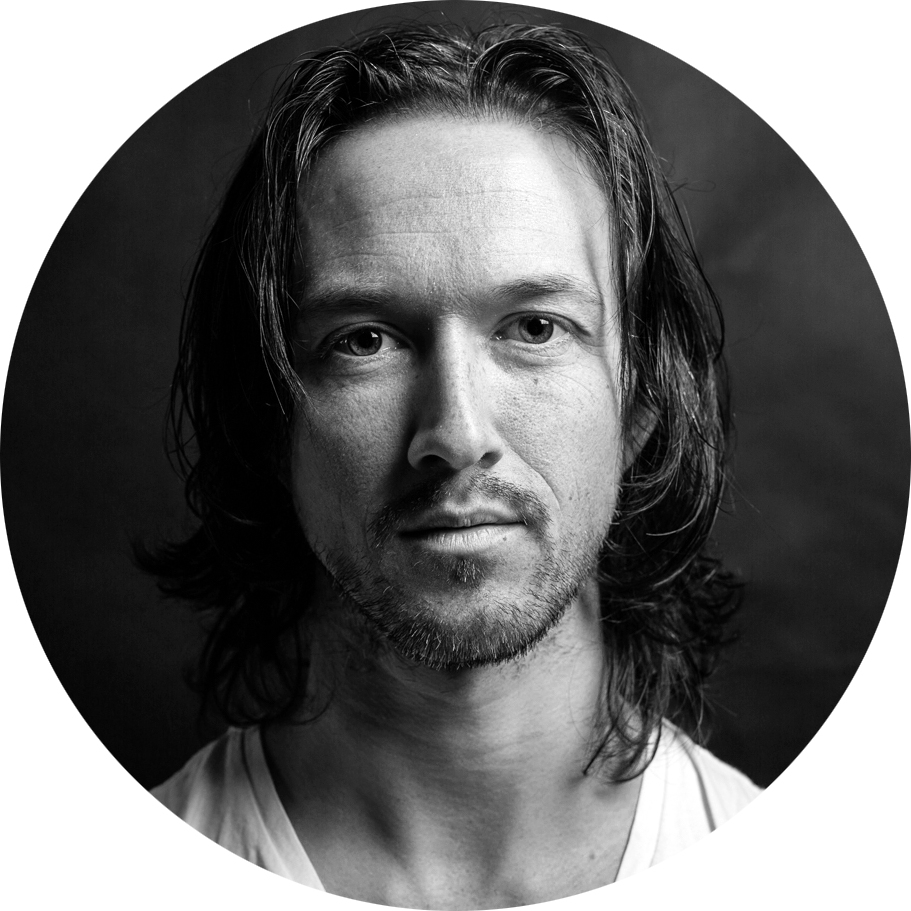
YOUR HOST: Brendan D. Murphy
Author of critically acclaimed “masterpiece” The Grand Illusion, and co-founder of Trooth network (the Fedbook alternative for truth-seekers and truth-speakers) – where free speech lives.
Rate and Leave a Review on iTunes
How to leave a rating or review in Apple Podcasts (on an iOS device)
- Open the Podcasts app
- Choose “Search” from the bottom row of icons and enter (i.e., “Truthiverse”) into the search field
- At the top of the page, select the show under Shows (not under Episodes)
- Scroll down past the first few episodes until you see Ratings & Reviews
- Click “Write a Review” underneath the displayed reviews from other listeners. You’ll then have the option to rate Truthiverse from 1-5 stars, and write a review if you choose (you can rate without writing if you’d prefer)

How to leave a rating or review in iTunes (on a computer from a web browser)
- Visit our Apple Podcasts page in your web browser
- Click “Listen on Apple Podcasts” to the right of our logo; then accept the pop-up asking if you want to launch iTunes
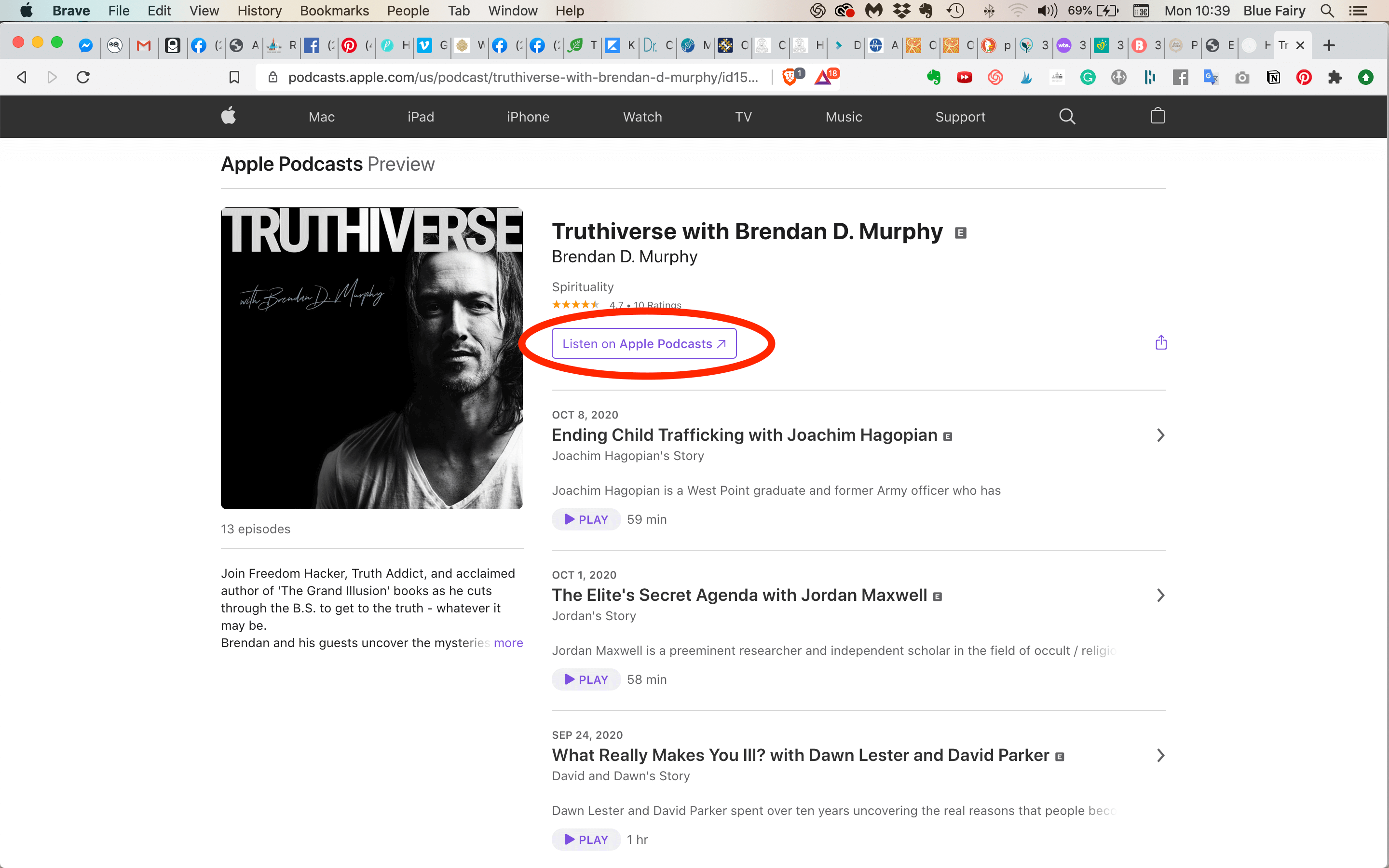
- In iTunes, click “Ratings & Reviews” under the main title
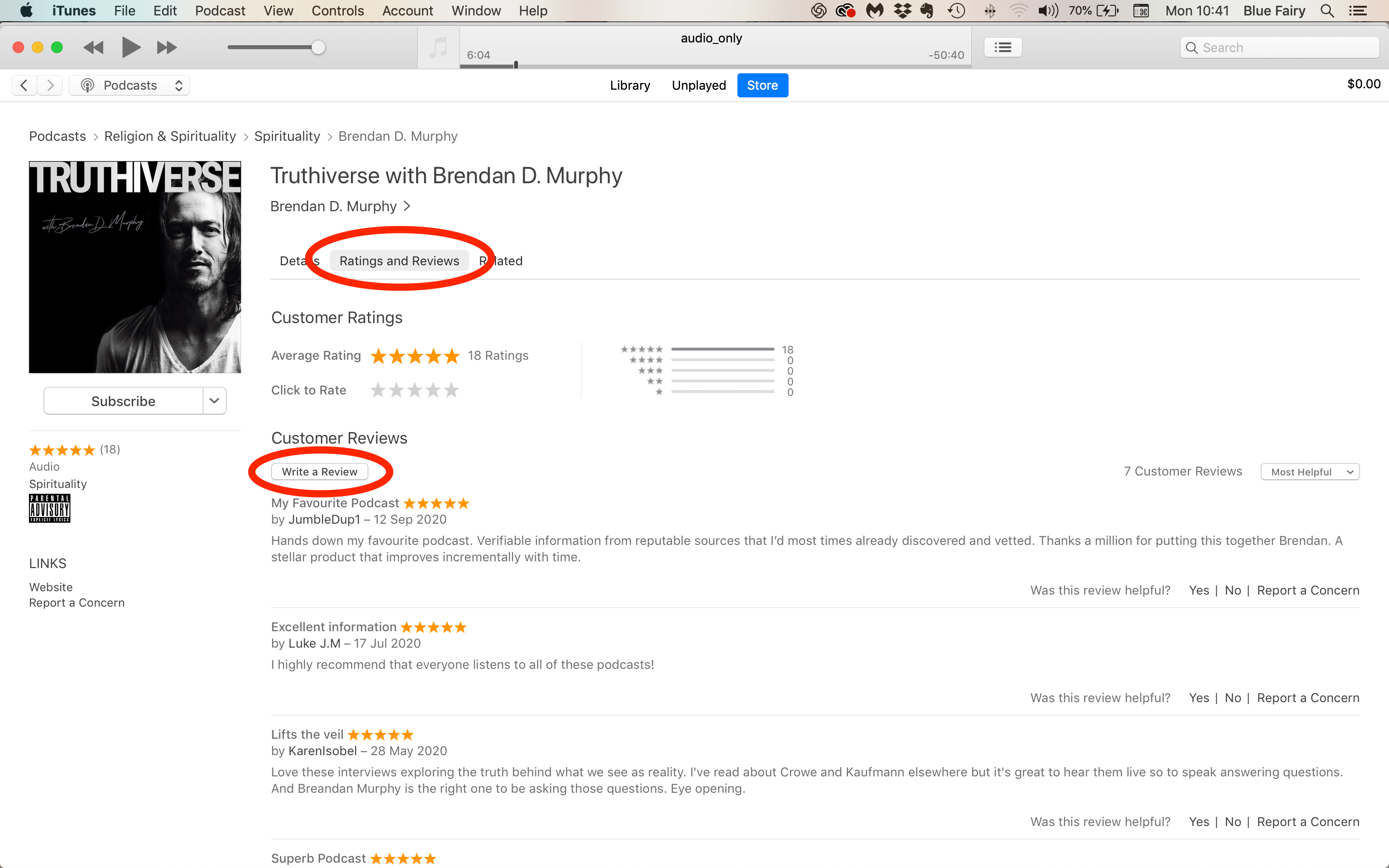
- To rate Truthiverse, select a number of stars between 1 and 5 next to the words “Click to rate” under the Customer Ratings headline
- To write a review, click “Write a Review” under the Customer Reviews heading
